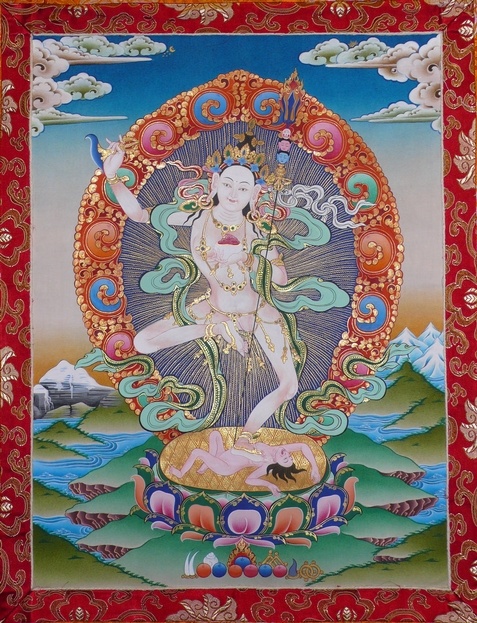
| LOST SADHANAS.ORG | THE LOST SADHANAS PROJECT |

Having finished the lost sadhana of the Bodhi Tree, we now move on to the introduction to sadhanas provided by the Vajra Dakini.
The Vajra Dakini says,
As yidam, my traditional role is both guide and revealer. The guide role is more commonly encountered by those who follow accepted teachings. Revealer of a new teachings is a rare role, and not one encouraged by traditional lineages. They do not wish to alter the canon, or accept outside teachings, and debates over which teaching is superior can become acrimonious.But some lost revelations are important, because Vajrayana Buddhism as currently practiced is skewed in the direction of wisdom, and away from love.
While high lamas speak of the importance of compassion, they use the word bodhicitta, a state of mind desiring enlightenment, rather than karuna, love or mercy. Vajrayana is an outgrowth of Mahayana, and not Theravada. The meditative focus should be on the Buddha, the bodhisattva, and the yidam, not just looking at emptiness. Mahayana gives joy and bliss, not only nothingness. As deity yoga is often practiced today, the practitioner identifies with the deity, and realizes the inner emptiness of both. There is no bond of love towards the deity, Buddha, or yidam, no devotion, no salvation of other persons. Indeed, with the doctrine of anatman, there is nobody to be compassionate towards.
As Hinduism and Buddhism mingled in the travel over the Himalayas, two styles developed, the yogic and the devotional. In the yogic fusion, the goal was the ending of suffering by denying its existence. This denial spread to all experience, and it became the dominant Buddhist position. Yet this approach denies the first noble truth.
The other approach ended suffering by understanding it as one experience among others, one emotion amidst a world of other emotions. This approach became the minority view, and it was subdivided into devotional Buddhism, where Buddhas and Bodhisattvas were figures of love, and the tantric style where the intermediate experiences of the supernatural realms were emphasized. Emotions and feelings became a ladder to infinite awareness, and early on emotion was important in both styles.
But the dominant form of Vajrayana Buddhism became philosophical, with empty ideas in empty persons leading to a liberation from suffering that possessed nothing of value in its place. Devotion became only an illusion, as much of an obstacle as desire.
The Mahayana ideas were reduced to ethics. Love meant not eating meat, or fighting, as opposed to having a relationship with a deity. The great path to salvation did not lead to bliss, it led to non-action. Today there is engaged Buddhism, which is more active but not more devotional. It still accepts the doctrine of anatman, which destroys compassion.
I am concerned with what has been lost in Buddhist teachings. I am concerned about the disintegration of devotion as a part of the Vajrayana path today, with the yidams as figures to be used and thrown away. Buddhas and their paradises also have no value, they are illusions to be discarded in the face of nirvana.
We are all bodhisattvas, even the yidams that appear frightening. We help and protect souls on their way to perfect freedom, which is not empty but radiating light and bliss. It is the devotional aspect that we wish to return.
Please click on the [ NEXT ] link below to continue.
[ BACK ] The Significance of the Vajra Symbol [ NEXT ] Vajradhara and the Emanation of Vajra Dakini
Introduction | Methodology - Participant/Observer | The Bodhi Tree Sadhanas | Vajra Dakini Discussion | Vajra Dakini Commentary | Vajra Dakini Sadhanas | Vajra Yogini Commentary | Maitreya Sadhanas | Vajradhara Speaks About Yidams | Lost Sadhanas Conclusion
Home
Copyright © 2021, J. Denosky, All Rights Reserved